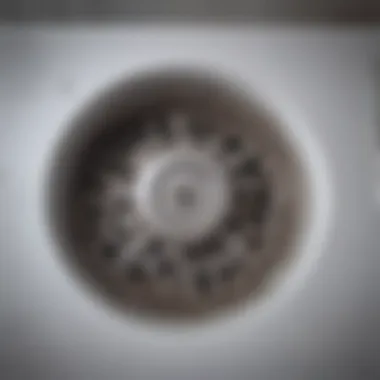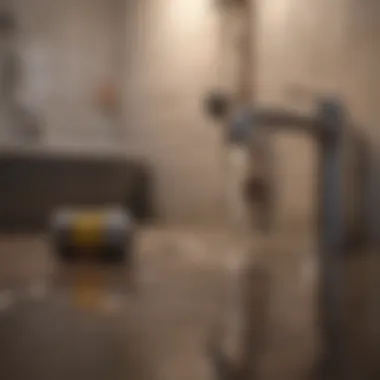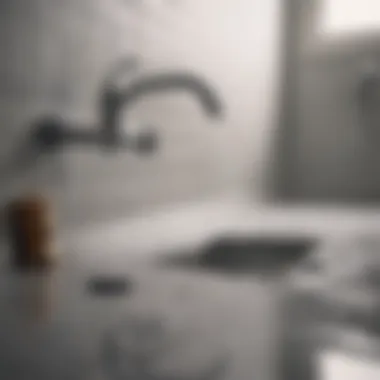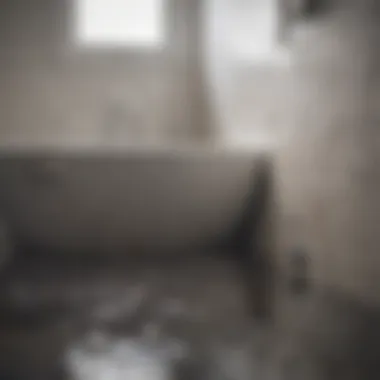How to Fix Bathroom Drain Problems Effectively


Intro
Bathroom drain issues are often a source of frustration for homeowners. These problems can disrupt daily routines and lead to costly repairs. Understanding the causes and solutions to these issues is essential for maintaining a functional home. This guide examines the common problems associated with bathroom drains, tools needed to address them, practical solutions, and strategies to prevent future blockages.
By tackling drain problems proactively, you can avoid the inconvenience and potential damages that follow serious clogs. Whether you are a novice homeowner or an experienced DIY enthusiast, this comprehensive guide will empower you with the knowledge and skills to resolve drain issues effectively.
Preamble
Bathroom drain issues are not just a household nuisance; they can easily escalate into more significant plumbing problems if not addressed promptly. Understanding how to diagnose and resolve these issues is essential for maintaining hygiene and functionality in any home. This article aims to equip homeowners and DIY enthusiasts with a detailed guide that covers everything from identifying common drain problems to implementing effective repair techniques.
The bathroom is a high-traffic area, and its plumbing system is subject to various challenges including hair, soap residue, and mineral buildup. These elements can contribute to slow drainage and clogs over time, making it vital for homeowners to be vigilant about their bathroom drain health.
By mastering the skills and techniques outlined in this guide, you can avoid costly repairs and prolong the lifespan of your plumbing systems. Moreover, the knowledge gained will empower you to tackle issues independently, fostering a sense of achievement while ensuring your bathroom remains functional and inviting.
In this article, we will explore the components of bathroom drain systems, identify common problems, and provide practical solutions for effective repair. Additionally, we will emphasize the significance of preventative measures, helping you maintain optimal drainage.
Engaging in proactive maintenance is key. Issues that seem minor at first can lead to significant repercussions down the line, including water damage and plumbing malfunctions. Armed with this comprehensive guide, you'll be well prepared to address bathroom drain challenges head-on, ensuring that your home remains a comfortable and functional space.
Understanding Bathroom Drain Systems
Understanding bathroom drain systems is crucial for anyone tackling plumbing issues. A well-functioning drain system prevents a range of problems, from slow drainage to complete blockages. Knowing how these systems work allows homeowners to identify issues early. This understanding also helps to make informed decisions when considering repairs or upgrades.
Components of a Bathroom Drain
Every bathroom drain system consists of several key components. The main parts include:
- Drainpipe: This channel carries wastewater to the sewer or septic system. It is usually made from PVC or ABS plastic.
- Traps: A trap is a U-shaped pipe designed to hold a small amount of water. This water creates a seal that prevents foul odors from entering the bathroom.
- Vent pipes: These pipes allow air into the drainage system, enabling proper drainage. They help maintain atmospheric pressure within the drainage system.
- Cleanouts: These are access points that allow for cleaning and removal of clogs from the drain.
- P-trap: This specific trap is common under sinks. It holds water in the curve, stopping gases from washing back into the bathroom.
Understanding these components helps identify the specific area where problems may occur. Problems could stem from clogs in the trap or broken vent pipes, for instance. Regular inspection can eliminate many issues before they escalate.
How Drainage Works
The basic function of a drainage system is to move wastewater away efficiently. Here's how it typically functions:
- Gravity: Drainage relies primarily on gravity. Wastewater flows down the drainpipe into the sewer or septic system. This gravitational pull must be strong enough to prevent backflow.
- Siphoning Effect: Traps create a siphon. When water drains through, it creates pressure changes that help pull water down through subsequent pipes.
- Ventilation: Vent pipes play an essential role. They allow air to enter the system. This air pressure helps water flow smoothly and prevents clogs.
- Natural Slopes: Pipes must be sloped adequately. A good rule of thumb is a quarter inch slope for every horizontal foot of pipe. This slope ensures that water can flow without pooling.
"Properly understanding how drainage works can prevent many common issues. Engage with your plumbing with confidence knowing these fundamentals."
Impairments in any of these processes can lead to a variety of issues, including slow drains and bad odors. Recognizing these functions empowers homeowners to tackle issues efficiently and effectively. Understanding bathroom drainage is an essential step in maintaining a healthy plumbing system.
Identifying Common Drain Problems
Understanding common drain problems is essential for maintaining the functionality and hygiene of your bathroom. Ignoring these issues can lead to more severe plumbing complications and increased repair costs. Recognizing the signs early allows for timely interventions, which can prevent extensive damages. In this section, we will delve into the most prevalent problems associated with bathroom drains: slow drains, complete clogs, and unpleasant odors.
Slow Drains
Slow drains are often the first indication that a problem exists in your plumbing system. When water begins to pool or move sluggishly in the sink, bathtub, or shower, it suggests that there is a buildup of debris obstructing normal flow. This situation could stem from hair, soap residue, or even mineral deposits, particularly in areas with hard water. While a slow drain may seem like a minor annoyance, it can escalate into a complete blockage if not addressed promptly.
To mitigate this issue, home owners should regularly check and maintain their drains. Simple actions like using a drain strainer to catch hair and other particles can reduce the amount of debris entering the pipes. Additionally, periodic cleaning with a mix of baking soda and vinegar can effectively dissolve minor clogs and avoid more significant plumbing troubles.
Complete Clogs


Complete clogs present a more dire situation than slow drains. When water no longer drains at all, it signifies a significant blockage in the system, often requiring immediate attention. This could be caused by an accumulation of materials like hair, soap scum, or even larger objects inadvertently flushed away. In some cases, tree roots may penetrate underground pipes, resulting in severe obstructions.
A complete clog demands a careful diagnostic approach. Homeowners should consider trying a plunger or a plumber's snake to dislodge the blockage. If these methods fail, professional assistance may be necessary to address the problem effectively. It is crucial not to resort to excessive chemical drain cleaners as they can inflict further damage on the plumbing infrastructure.
Unpleasant Odors
Unpleasant odors coming from bathroom drains can be both a nuisance and an indicator of underlying issues. A foul smell often suggests the presence of trapped organic matter or sewer gas, which comes from a failing drain trap. It could also indicate that the venting systems are compromised, allowing unpleasant gases to escape back into the bathroom.
To combat these odors, regular cleaning and maintenance are paramount. Homeowners may use solutions such as baking soda combined with vinegar to neutralize odors. Ensuring that the trap is functioning correctly and that there are no leaks will also help in maintaining a fresh environment. In some circumstances, consulting a plumbing expert might be warranted to address any deeper issues related to the home’s plumbing configuration.
Maintaining vigilant awareness of these common drain problems can save homeowners time, money, and a considerable amount of inconvenience.
Addressing occasional slow drains or unusual odors promptly and effectively can be the difference between minor maintenance and costly repairs.
Tools and Materials for Drain Repair
Understanding the right tools and materials is crucial for effective bathroom drain repair. Having the correct items on hand can save both time and frustration. Whether you are addressing a minor blockage or engaging in a more complex repair, the right tools can simplify the process greatly. Furthermore, using appropriate cleaning solutions is vital for maintaining a healthy drainage system, which directly impacts the longevity and efficiency of your plumbing.
Investing in quality tools and materials not only aids in resolving existing issues but also serves as a preventative measure against future problems. Proper tools allow for more effective techniques, reducing the likelihood of damage to your plumbing. It is essential to identify both essential tools and effective cleaning solutions to tackle various drain issues efficiently.
Essential Tools
When it comes to drain repair, several tools stand out as indispensable. Here is a list of essential tools you should have:
- Plunger: This is often the first tool used for drain issues. A plunger creates suction that can dislodge a blockage.
- Drain Snake: A drain snake can reach deep into pipes to remove stubborn clogs that are out of reach for other tools.
- Pipe Wrench: This helps in holding and turning pipes securely during repairs.
- Bucket: Useful for catching water and debris when disassembling parts of the drain.
- Gloves: Protect your hands from chemicals and debris when working on drains.
- Flashlight: A flashlight helps illuminate dark spaces under sinks or behind toilets, ensuring you have a clear view during repairs.
Having these tools ready can make the repair process smoother and more efficient. Without them, you might face unnecessary delays and complications.
Cleaning Solutions
Cleaning solutions play a vital role in maintaining clear and functioning drains. Various options are available, from commercial products to natural alternatives. Here’s an overview:
- Commercial Drain Cleaners: These are chemically formulated to dissolve clogs effectively. Brands like Drano or Liquid-Plumr can be used for severe blockages. However, caution is needed as chemical cleaners can be harsh on pipes, especially older ones.
- Homemade Solutions: Often a safer choice, solutions made from vinegar and baking soda can dissolve minor clogs without harming your plumbing. Mixing these two ingredients can create a fizzing action that helps break down debris.
- Enzymatic Cleaners: These cleaners use enzymes to break down organic matter in drains. They are generally safe for all plumbing types and are less aggressive than chemical cleaners.
Selecting the right cleaning solution is essential. It ensures that you do not exacerbate any existing issues or cause future damage. Always consider the type of blockage and the condition of your pipes when choosing a solution.
Keeping your bathroom drains clear and in good working order requires the right tools and cleaning solutions. Being prepared will help you tackle most drain issues confidently.
Step-by-Step Repair Methods
Understanding step-by-step repair methods is crucial in effectively resolving bathroom drain issues. Each method outlined in this guide offers practical and straightforward solutions. Knowing these techniques empowers homeowners to take action before considering professional help. It also helps in minimizing potential damage and costs associated with plumbing problems. The methods are designed to address specific issues and can often restore drain functionality without complex interventions.
Using a Plunger
A plunger is one of the most foundational tools for tackling drain clogs. It operates by creating a vacuum that can dislodge blockages effectively. To use a plunger:
- Cover the overflow drain. For bathtubs or sinks, ensure that any overflow outlet is sealed.
- Position the plunger. Place it over the drain opening, ensuring a tight seal.
- Push down and pull up. Work the plunger vigorously for about 10-15 seconds.
- Check the drain. If water begins to drain down, the plunger worked; repeat as necessary.
This method is often the first line of defense and can resolve many common clogs quickly.
Applying a Drain Cleaner


Using a drain cleaner is another common method for addressing clogs. There are various types of drain cleaners; some are chemical-based, while others are enzyme-based. It’s important to follow the instructions on the label. Here’s a generic overview of the process:
- Select the appropriate cleaner. Choose a product that is suitable for your plumbing.
- Pour into the drain. Carefully add the cleaner, allowing it to sit as recommended.
- Flush with water. After the set time, use hot water to flush the drain.
Always keep safety in mind. Wear gloves and goggles to protect yourself from splashes when using chemical cleaners.
Removing the Trap
Removing the trap is an effective way to clear out stubborn clogs that cannot be resolved by other means. This method involves:
- Locating the trap. It is usually found under the sink.
- Placing a bucket below. This will catch any water or debris that spills out.
- Unscrewing the trap. Carefully take it apart using a wrench if necessary.
- Cleaning the trap. Remove any buildup or clogs before reassembling.
By doing this, you have direct access to a common problem area and can significantly improve drainage.
Utilizing a Snake Auger
The snake auger is a more advanced tool for severe clogs. It is designed to reach further down the drain and break up blockages. To use it:
- Insert the snake. Feed it into the drain until you feel resistance.
- Turn the handle. This allows the auger to break up the clog.
- Pull out the snake. Remove any debris that collects on the auger.
This method is useful for clearing deeper clogs that are beyond the reach of a plunger or drain cleaner.
Disassembling the Drain Assembly
If other methods fail, disassembling the entire drain assembly may be necessary. This process is more complicated but can offer a comprehensive solution:
- Turn off the water supply. Ensure no water flows during this process.
- Remove all visible screws. Take apart any connected components carefully.
- Inspect each part carefully. Look for blockages or damage that requires addressing.
- Reassemble once cleaned. After thorough cleaning and inspection, put everything back together.
This method is often the last resort and should be approached with caution, yet it can be very effective for persistent issues.
Preventative Measures
Preventative measures play a crucial role in maintaining the integrity of bathroom drain systems. By implementing these practices, homeowners can mitigate common drain problems before they escalate into serious issues. Not only do preventative strategies save time and money, but they also enhance the overall functionality of the plumbing system.
One specific element to consider is the frequency of maintenance. Regular inspections can reveal early signs of wear and potential clogs, providing an opportunity to address them proactively. Additionally, understanding the impact of different materials on drainage is essential. For example, hair and soap residues are common culprits for slow drains. Being mindful of what goes down the drain can drastically reduce the frequency of clogs.
Benefits of proactive measures include prolonging the lifespan of the drain system, reducing plumbing emergencies, and increasing home value. When potential issues are avoided, an efficient drainage system contributes to a more pleasant living environment.
Considerations must also include the balance between DIY solutions and professional help. While many strategies can be managed independently, some situations demand an expert’s insight. Knowing when to seek professional assistance is vital in avoiding unnecessary complications.
"An ounce of prevention is worth a pound of cure."
In summary, adopting preventative measures ensures a smoother and more effective bathroom experience, while also safeguarding your plumbing investment.
Regular Maintenance Tips
For optimal drain performance, regular maintenance is key. Simple, consistent actions can prevent many common issues. Here are some practical tips:
- Clean out hair and debris from stoppers and drains after each use.
- Flush the drains monthly with hot water to help dissolve potential clogs.
- Use a mixture of vinegar and baking soda to clear minor buildups. Let it sit for fifteen minutes before rinsing with hot water.
- Check for leaks or pooling water around fixtures regularly.
- Monitor drain flow and address any slow drains promptly.
By staying vigilant, homeowners can address potential hindrances before they lead to more serious complications.


DIY Drain Protection
Implementing DIY drain protection strategies can significantly reduce the number of problems encountered. Here are some effective options:
- Install a drain screen to catch hair and larger debris, preventing them from entering the plumbing system.
- Avoid pouring grease or oil down the drain, as they solidify and can lead to blockages.
- Dispose of food waste in the trash rather than the sink, even if you have a disposal unit.
- Regularly remove and clean the trap, as this can help prevent buildup.
- Educate family members on proper drain usage and what can potentially harm the plumbing system.
By incorporating these simple practices, individuals can maintain a functional and efficient bathroom drainage system.
When to Call a Professional
In some situations, handling bathroom drain issues can quickly become overwhelming. While many problems can be resolved through DIY methods, there are instances when it is more wise to seek professional assistance. Understanding these moments adds value to your maintenance efforts and can save you time and money in the long run.
Identifying Serious Issues
Not every plumbing problem is a simple clog. Knowing the signs of a more serious issue is crucial. For instance, if multiple drains in your home are slow or backing up at the same time, it may indicate a blockage in the main sewer line rather than just a localized issue.
Leaking pipes can also signal potential damage that needs a professional touch. Over time, leaks can lead to water damage, mold growth, and even structural issues within your home.
Look out for the following signs:
- Unusual noises: Gurgling sounds in drains may be a sign of trapped air or a significant blockage.
- Consistent odors: Foul smells may point to sewage issues, which should never be ignored.
- Wet spots: Water pooling around the base of fixtures could indicate leaking underneath.
- Reduced water pressure: This may hint at larger plumbing problems.
If you notice these issues, calling a professional might be the best and safest choice.
Understanding Costs versus DIY
Cost is often a major deciding factor when considering whether to DIY or hire a professional. Simple tasks such as using a plunger or a drain snake may save you money. However, this doesn't apply to all situations.
Professional services can be quite costly, but they are valuable for several reasons:
- Expertise: Professionals have knowledge that ensures all issues are identified and resolved efficiently.
- Tools and equipment: Many plumbing problems require specialized tools that most homeowners do not own.
- Time-saving: Hiring a pro can mean a faster resolution, ultimately saving you time and frustration.
On the other hand, consider the following before opting for professional help:
- The complexity of the problem.
- Your personal experience with plumbing repairs.
- The potential for further damage if mistakes are made during DIY attempts.
Finale
In closing, it is imperative to recognize the significance of understanding and resolving bathroom drain issues. This understanding directly affects not just the functionality of a home but also the overall hygiene and comfort of the living environment. A functioning drainage system is essential, not only for daily tasks but also for preventing potential health hazards that can arise from stagnant water and foul odors.
Through the course of this article, we have delved into various aspects of bathroom drain systems. We explored the components that make up these systems and their function. Knowing how drainage works helps in diagnosing problems accurately, leading to more efficient solutions. Identifying common issues such as slow drains, complete clogs, and unpleasant odors empowers homeowners to tackle these problems early, minimizing the need for costly repairs.
The article provided insights into essential tools and materials needed for drain repair. This information is valuable because the right tools can significantly ease the repair process. Step-by-step methods for resolving different types of blockages were outlined, ensuring readers can take action confidently when confronted with drain problems.
Additionally, preventative measures were discussed. Regular maintenance and DIY tips not only enhance the longevity of the drainage system but also reduce the chances of future issues. This proactive approach is critical for homeowners and DIY enthusiasts alike, creating a sense of ownership in one’s environment.
Understanding when to seek professional help is equally important. Serious issues can escalate quickly, leading to more significant damage and higher costs. By weighing the benefits of professional services against DIY efforts, individuals can make informed decisions that best suit their circumstances.
The knowledge gained from this article serves as a powerful tool for managing bathroom drain issues effectively. Recognizing early signs of trouble, having the right equipment on hand, and knowing when to act are all skills that can save time, money, and stress. Therefore, ongoing attention to bathroom drainage systems should be a priority for anyone who values a clean and functional home.
Importance of Additional Resources
- Broadened Knowledge: Expanding your understanding of plumbing can help prevent future issues.
- Techniques and Tools: Discover specialized tools and methods that may be unfamiliar.
- Practical Examples: Real-world applications and testimonials provide perspective.
- Continual Learning: Plumbing is an evolving field; keeping updated can aid in better home management.
By investing time in additional resources, you empower yourself with knowledge that enhances both your skills and confidence in tackling drain issues.
Considerations About Additional Resources
- Ensure that the resources are credible and based on solid expertise.
- Look for materials that are inclusive of various skill levels, to cater to both novice and experienced individuals.
- Engage with resources that illustrate practical applications, giving a clearer picture of potential challenges.



